The Counterculture Movement 1965-1971
The Counterculture refers to an anti-establishment cultural phenomenon that developed first in the United States and then spread throughout much of the Western world between the early 1960s and the mid-1970s, with New York City, and San Francisco being hotbeds of early countercultural activity.
The aggregate movement gained momentum as the American Civil Rights Movement continued to grow, and became revolutionary with the expansion of the US government’s extensive military intervention in Vietnam. As the 1960s progressed, widespread social tensions also developed concerning other issues, and tended to flow along generational lines regarding human sexuality, women’s rights, traditional modes of authority, experimentation with psychoactive drugs, and differing interpretations of the American Dream.
As the era unfolded, new cultural forms and a dynamic subculture which celebrated experimentation, modern incarnations of Bohemianism, and the rise of the hippie and other alternative lifestyles, emerged. This embracing of creativity is particularly notable in the works of British Invasion bands such as the Beatles, and filmmakers whose works became far less restricted by censorship. In addition to the trendsetting Beatles, many other creative artists, authors, and thinkers, within and across many disciplines, helped define the counterculture movement.
 Several factors distinguished the counterculture of the 1960s from the anti-authoritarian movements of previous eras. The post-World War II “baby boom” generated an unprecedented number of potentially disaffected young people as prospective participants in a rethinking of the direction of American and other democratic societies.
Several factors distinguished the counterculture of the 1960s from the anti-authoritarian movements of previous eras. The post-World War II “baby boom” generated an unprecedented number of potentially disaffected young people as prospective participants in a rethinking of the direction of American and other democratic societies.
Post-war affluence allowed many of the counterculture generation to move beyond a focus on the provision of the material necessities of life that had preoccupied their Depression-era parents. The era was also notable in that a significant portion of the array of behaviors and “causes” within the larger movement were quickly assimilated within mainstream society, particularly in the US, even though counterculture participants numbered in the clear minority within their respective national populations.
The counterculture era essentially commenced in earnest with the assassination of John F. Kennedy in November 1963. It became absorbed into the popular culture with the termination of U.S. combat-military involvement in Southeast Asia and the end of the draft in 1973, and ultimately with the resignation of President Richard Nixon in August 1974.
Many key movements were born of, or were advanced within, the counterculture of the 1960s. Each movement is relevant to the larger era. The most important stand alone, irrespective of the larger counterculture. In the broadest sense, 1960s counterculture grew from a confluence of people, ideas, events, issues, circumstances, and technological developments which served as intellectual and social catalysts for exceptionally rapid change during the era.
Free Speech Movement
Free Speech Movement was a student protest which took place during the 1964–65 academic year on the campus of the University of California, Berkeley under the informal leadership of students Mario Savio, Jack Weinberg, Michael Rossman, Brian Turner, Bettina Aptheker, Steve Weissman, Art Goldberg, Jackie Goldberg, and others.
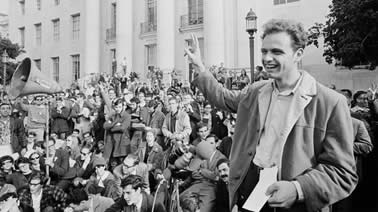 In protests unprecedented in scope, students insisted that the university administration lift the ban of on-campus political activities and acknowledge the students’ right to free speech and academic freedom. Sol Stern, a former radical who took part in the Free Speech Movement, stated in a 2014 City Journal article that the group viewed the United States to be both racist and imperialistic and that the main intent after lifting Berkeley’s loyalty oath was to build on the legacy of C. Wright Mills and weaken the Cold War consensus by promoting the ideas of the Cuban Revolution.
In protests unprecedented in scope, students insisted that the university administration lift the ban of on-campus political activities and acknowledge the students’ right to free speech and academic freedom. Sol Stern, a former radical who took part in the Free Speech Movement, stated in a 2014 City Journal article that the group viewed the United States to be both racist and imperialistic and that the main intent after lifting Berkeley’s loyalty oath was to build on the legacy of C. Wright Mills and weaken the Cold War consensus by promoting the ideas of the Cuban Revolution.
Civil Rights
Civil Rights encompasses social movements in the United States whose goals were to end racial segregation and discrimination against African Americans and to secure legal recognition and federal protection of the citizenship rights enumerated in the Constitution and federal law. This article covers the phase of the movement between 1954 and 1968, particularly in the South. The leadership was African American, and much of the political and financial support came from labor unions (led by Walter Reuther), major religious denominations, and prominent white Democratic Party politicians such as Hubert Humphrey and Lyndon B. Johnson and white Republican Party politicians such as Governor Nelson Rockefeller and Senator Everett Dirksen.
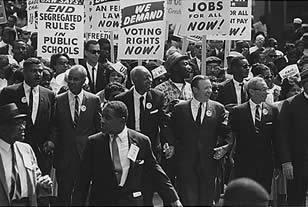 The movement was characterized by major campaigns of civil resistance. Between 1955 and 1968, acts of nonviolent protest and civil disobedience produced crisis situations and productive dialogues between activists and government authorities. Federal, state, and local governments, businesses, and communities often had to respond immediately to these situations, which highlighted the inequities faced by African Americans. Forms of protest and/or civil disobedience included boycotts such as the successful Montgomery Bus Boycott (1955–56) in Alabama; “sit-ins” such as the influential Greensboro sit-ins (1960) in North Carolina; marches, such as the Selma to Montgomery marches (1965) in Alabama; and a wide range of other nonviolent activities.
The movement was characterized by major campaigns of civil resistance. Between 1955 and 1968, acts of nonviolent protest and civil disobedience produced crisis situations and productive dialogues between activists and government authorities. Federal, state, and local governments, businesses, and communities often had to respond immediately to these situations, which highlighted the inequities faced by African Americans. Forms of protest and/or civil disobedience included boycotts such as the successful Montgomery Bus Boycott (1955–56) in Alabama; “sit-ins” such as the influential Greensboro sit-ins (1960) in North Carolina; marches, such as the Selma to Montgomery marches (1965) in Alabama; and a wide range of other nonviolent activities.
This phase of the Civil Rights Movement witnessed the passage of several major pieces of federal legislation. The Civil Rights Act of 1964, expressly banned discrimination based on race, color, religion, sex, or national origin in employment practices and ended unequal application of voter registration requirements and racial segregation in schools, at the workplace, and by public accommodations. The Voting Rights Act of 1965 restored and protected voting rights for minorities. The Immigration and Nationality Services Act of 1965 removed racial and national barriers and opened the way for black immigrants from Africa and the Western Hemisphere. The Fair Housing Act of 1968 banned discrimination in the sale or rental of housing. African Americans re-entered politics in the South, and across the country young people were inspired to take action.
 A wave of inner city riots in black communities from 1964 through 1970 undercut support from the white community. The emergence of the Black Power movement, which lasted from about 1966 to 1975, challenged the established black leadership for its cooperative attitude and its nonviolence, and instead demanded political and economic self-sufficiency.
A wave of inner city riots in black communities from 1964 through 1970 undercut support from the white community. The emergence of the Black Power movement, which lasted from about 1966 to 1975, challenged the established black leadership for its cooperative attitude and its nonviolence, and instead demanded political and economic self-sufficiency.
Many popular representations of the movement are centered on the leadership and philosophy of Martin Luther King, Jr., who won the 1964 Nobel Peace Prize for his role in the movement. But, some scholars note that the movement was too diverse to be credited to one person, organization, or strategy.
Swinging London
Swinging London is a catch-all term applied to the fashion and cultural scene that flourished in London in the 1960s. It consisted largely of music, discothèques, and mod fashion.
Background
Swinging London was a youth-oriented phenomenon that emphasized the new and modern. It was a period of optimism and hedonism and a cultural revolution. One catalyst was the recovery of the British economy after post-World War II austerity which lasted through much of the 1950s.
“Swinging London” was defined by Time magazine in its issue of 15 April 1966 and celebrated in the name of the pirate radio station, Swinging Radio England, that began shortly afterward. However, “swinging” in the sense of hip or fashionable had been used since the early 1960s, including by Norman Vaughan in his “swinging/dodgy” patter on Sunday Night at the London Palladium.
In 1965, Diana Vreeland, editor of Vogue magazine, said: “London is the most swinging city in the world at the moment.” Later that year, the American singer Roger Miller had a hit record with “England Swings”, which steps around the progressive youth culture (both musically and lyrically).
1967 saw the release of Peter Whitehead’s cult documentary film Tonite Lets All Make Love in London which accurately summed up both the culture of Swinging London through celebrity interviews, and the music with its accompanying soundtrack release featuring Pink Floyd.
Music

The Kinks in 1967
Already heralded by Colin MacInnes’ 1959 novel Absolute Beginners, Swinging London was underway by the mid-1960s and included music by the Beatles, the Rolling Stones, the Kinks, the Who, the Small Faces, and other artists from what was known in the United States as the “British Invasion”.
Psychedelic rock from artists such as the Jimi Hendrix Experience, Pink Floyd, Cream, and Traffic grew significantly in popularity. This sort of music was heard in the United Kingdom over pirate radio stations such as Radio Caroline, Wonderful Radio London, and Swinging Radio England because the BBC did not allow this on their radio station.
Fashion and symbols
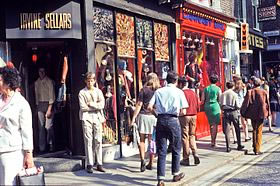
Carnaby Street, circa 1968.
During the time of Swinging London, fashion and photography were featured in Queen magazine, which drew attention to fashion designer Mary Quant.
The model Jean Shrimpton was another icon and one of the world’s first supermodels. She was the world’s highest-paid and most photographed model during this time. Shrimpton was called “The Face of the ’60s”, in which she has been considered by many as “the symbol of Swinging London” and the “embodiment of the 1960s”.
 Other popular models of the era included Veruschka, Peggy Moffitt, and Penelope Tree. The model Twiggy has been called “the face of 1966” and “the Queen of Mod,” a label she shared with others, such as Cathy McGowan, who hosted the television rock show, Ready Steady Go! from 1964 to 1966.
Other popular models of the era included Veruschka, Peggy Moffitt, and Penelope Tree. The model Twiggy has been called “the face of 1966” and “the Queen of Mod,” a label she shared with others, such as Cathy McGowan, who hosted the television rock show, Ready Steady Go! from 1964 to 1966.
Mod-related fashions such as the miniskirt stimulated fashionable shopping areas such as Carnaby Street and King’s Road, Chelsea. The fashion was a symbol of youth culture.
The British flag, the Union Jack, became a symbol, assisted by events such as England’s home victory in the 1966 World Cup. The Mini-Cooper car (launched in 1959) was used by a fleet of mini-cab taxis highlighted by advertising that covered their paintwork.
The Beatles
T he Beatles were an English rock band, formed in Liverpool in 1960. With members John Lennon, Paul McCartney, George Harrison and Ringo Starr, they became widely regarded as the foremost and most influential act of the rock era. Rooted in skiffle, beat, and 1950s rock and roll, the Beatles later experimented with several musical styles, ranging from pop ballads and Indian music to psychedelia and hard rock, often incorporating classical elements and unconventional recording techniques in innovative ways.
he Beatles were an English rock band, formed in Liverpool in 1960. With members John Lennon, Paul McCartney, George Harrison and Ringo Starr, they became widely regarded as the foremost and most influential act of the rock era. Rooted in skiffle, beat, and 1950s rock and roll, the Beatles later experimented with several musical styles, ranging from pop ballads and Indian music to psychedelia and hard rock, often incorporating classical elements and unconventional recording techniques in innovative ways.
In the early 1960s, their enormous popularity first emerged as “Beatlemania”, but as the group’s music grew in sophistication, led by primary songwriters Lennon and McCartney, they came to be perceived as an embodiment of the ideals shared by the counterculture of the 1960s.
Sgt Peppers
Sgt Peppers is the eighth studio album by the English rock band the Beatles. Released on 1 June 1967, it was an immediate commercial and critical success, spending 27 weeks at the top of the albums chart in the United Kingdom and 15 weeks at number one in the United States. Time magazine declared it “a historic departure in the progress of music” and the New Statesman praised its elevation of pop to the level of fine art. It won four Grammy Awards in 1968, including Album of the Year, the first rock LP to receive this honor.
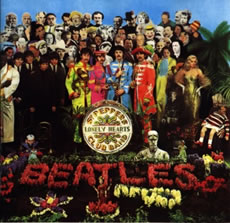 In August 1966, the Beatles permanently retired from touring and began a three-month holiday from recording. During a return flight to London in November, Paul McCartney had an idea for a song involving an Edwardian era military band that would eventually form the impetus of the Sgt. Pepper concept. Sessions for what was to become the Beatles’ eighth studio album began on 24 November in Abbey Road Studio Two with two compositions inspired from their youth, “Strawberry Fields Forever” and “Penny Lane”, but after pressure from EMI, the songs were released as a double A-side single and were not included on the album.
In August 1966, the Beatles permanently retired from touring and began a three-month holiday from recording. During a return flight to London in November, Paul McCartney had an idea for a song involving an Edwardian era military band that would eventually form the impetus of the Sgt. Pepper concept. Sessions for what was to become the Beatles’ eighth studio album began on 24 November in Abbey Road Studio Two with two compositions inspired from their youth, “Strawberry Fields Forever” and “Penny Lane”, but after pressure from EMI, the songs were released as a double A-side single and were not included on the album.
In February 1967, after recording “Sgt. Pepper’s Lonely Hearts Club Band”, McCartney suggested that the Beatles should release an entire album that would represent a performance by the fictional Sgt. Pepper band. This alter ego group would give them the freedom to experiment musically. During the recording sessions, the band endeavored to improve upon the production quality of their prior releases. Knowing they would not have to perform the tracks live, they adopted an experimental approach to composition, writing songs such as “With a Little Help from My Friends”, “Lucy in the Sky with Diamonds” and “A Day in the Life”. Producer George Martin and engineer Geoff Emerick’s innovative recording of the album included the liberal application of sound shaping signal processing and the use of a 40-piece orchestra performing aleatoric crescendos. Recording was completed on 21 April 1967. The cover, depicting the band posing in front of a tableau of celebrities and historical figures, was designed by the British pop artists Peter Blake and Jann Haworth.
British Invasion
British Invasion was a phenomenon that occurred in the mid-1960s when rock and pop music acts from the United Kingdom, as well as other aspects of British culture, became popular in the United States, and significant to the rising “counterculture” on both sides of the Atlantic. Pop and rock groups such as the Beatles, the Dave Clark Five, the Kinks, the Rolling Stones, Herman’s Hermits, the Animals, and the Who were at the forefront of the invasion.

Vietnam War
Vietnam War The Vietnam War, and the protracted national divide between supporters and opponents of the war, were arguably the most important factors contributing to the rise of the larger counterculture movement.

The widely accepted assertion that anti-war opinion was held only among the young is a myth, but enormous war protests consisting of thousands of mostly younger people in every major US city, and elsewhere across the Western world, effectively united millions against the war, and against the war policy that prevailed under five US congresses and during two presidential administrations.
Flower Power
Flower Power was a slogan used during the late 1960s and early 1970s as a symbol of passive resistance and non-violence ideology. It is rooted in the opposition movement to the Vietnam War. The expression was coined by the American beat poet Allen Ginsberg in 1965 as a means to transform war protests into peaceful affirmative spectacles. Hippies embraced the symbolism by dressing in clothing with embroidered flowers and vibrant colors, wearing flowers in their hair, and distributing flowers to the public, becoming known as flower children. The term later became generalized as a modern reference to the hippie movement and the so-called counterculture of drugs, psychedelic music, psychedelic art and social permissiveness.

Summer of Love
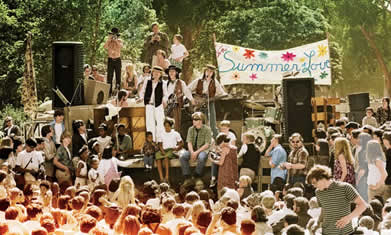 Summer of Love was a social phenomenon that occurred during the summer of 1967, when as many as 100,000 people, mostly young people sporting hippie fashions of dress and behavior, converged in San Francisco’s neighborhood Haight-Ashbury. Although hippies also gathered in many other places in the U.S., Canada and Europe, San Francisco was at that time the most publicized location for hippie fashions.
Summer of Love was a social phenomenon that occurred during the summer of 1967, when as many as 100,000 people, mostly young people sporting hippie fashions of dress and behavior, converged in San Francisco’s neighborhood Haight-Ashbury. Although hippies also gathered in many other places in the U.S., Canada and Europe, San Francisco was at that time the most publicized location for hippie fashions.
Hippies, sometimes called flower children, were an eclectic group. Many were suspicious of the government, rejected consumerist values, and generally opposed the Vietnam War. A few were interested in politics; others were concerned more with art (music, painting, poetry in particular) or religious and meditative practices.
“San Francisco (Be Sure to Wear Flowers in Your Hair)”
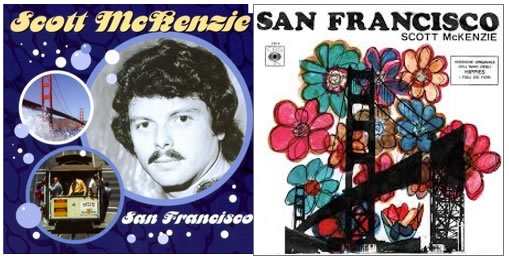
Musician John Phillips of the band The Mamas & the Papas wrote the song “San Francisco (Be Sure to Wear Flowers in Your Hair)” for his friend Scott McKenzie. It served to promote both the Monterey Pop Festival that Phillips was helping to organize and to popularize the flower children of San Francisco. Released on May 13, 1967, the song was an instant success. By the week ending July 1, 1967, it scored number four on the Billboard Hot 100 in the United States, where it remained for four consecutive weeks.Meanwhile, the song scored number one in the United Kingdom and much of Europe. The single is purported to have sold more than 7 million copies worldwide
The Who
The Who are an English rock band that formed in 1964. Their classic line-up consisted of lead singer Roger Daltrey, guitarist and singer Pete Townshend, bass guitarist John Entwistle, and drummer Keith Moon. They are considered one of the most influential rock bands of the 20th century, selling over 100 million records worldwide and holding a reputation for their live shows and studio work.
 The Who developed from an earlier group, the Detours, and established themselves as part of the pop art and mod movements, featuring auto-destructive art by destroying guitars and drums on stage. Their first single as the Who, “I Can’t Explain”, reached the UK top ten, followed by a string of singles including “My Generation”, “Substitute” and “Happy Jack”. In 1967, they performed at the Monterey Pop Festival and released the US top ten single “I Can See for Miles”, while touring extensively. The group’s fourth album, 1969’s rock opera Tommy, included the single “Pinball Wizard” and was a critical and commercial success.
The Who developed from an earlier group, the Detours, and established themselves as part of the pop art and mod movements, featuring auto-destructive art by destroying guitars and drums on stage. Their first single as the Who, “I Can’t Explain”, reached the UK top ten, followed by a string of singles including “My Generation”, “Substitute” and “Happy Jack”. In 1967, they performed at the Monterey Pop Festival and released the US top ten single “I Can See for Miles”, while touring extensively. The group’s fourth album, 1969’s rock opera Tommy, included the single “Pinball Wizard” and was a critical and commercial success.
Live appearances at Woodstock and the Isle of Wight Festival, along with the live album Live at Leeds, cemented their reputation as a respected rock act. With their success came increased pressure on lead songwriter and visionary Townshend, and the follow-up to Tommy, Lifehouse, was abandoned. Songs from the project made up 1971’s Who’s Next, which included the hit “Won’t Get Fooled Again”. The group released the album Quadrophenia in 1973 as a celebration of their mod roots, and oversaw the film adaptation of Tommy in 1975. They continued to tour to large audiences before semi-retiring from live performances at the end of 1976. The release of Who Are You in 1978 was overshadowed by the death of Moon shortly after.
The Kinks
The Kinks were an English rock band formed in Muswell Hill, North London, in 1963 by brothers Dave and Ray Davies. They are regarded as one of the most important and influential rock groups of the era. The band emerged in 1964 during the height of British rhythm and blues and Merseybeat. They were briefly part of the British Invasion of the US until their touring ban in 1965.
 Their third single, the Ray Davies penned “You Really Got Me”, became an international hit, topping the charts in the United Kingdom and reaching the Top 10 in the United States. Between the mid-1960s and early 1970s, the group released a string of hit singles; studio albums drew good reviews but sold less than compilations of their singles. They gained a reputation for reflecting English culture and lifestyle, fuelled by Ray Davies’ observational writing style.
Their third single, the Ray Davies penned “You Really Got Me”, became an international hit, topping the charts in the United Kingdom and reaching the Top 10 in the United States. Between the mid-1960s and early 1970s, the group released a string of hit singles; studio albums drew good reviews but sold less than compilations of their singles. They gained a reputation for reflecting English culture and lifestyle, fuelled by Ray Davies’ observational writing style.
Albums such as Something Else (1967), The Kinks Are the Village Green Preservation Society (1968), Arthur (1969), Lola Versus Powerman (1970), along with their accompanying singles, are considered among the most influential recordings of the period.
Jimi Hendrix
Jimi Hendrix was an American rock guitarist, singer, and songwriter. Although his mainstream career spanned only four years, he is widely regarded as one of the most influential electric guitarists in the history of popular music, and one of the most celebrated musicians of the 20th century. The Rock and Roll Hall of Fame describes him as “arguably the greatest instrumentalist in the history of rock music”.
 Born in Seattle, Washington, Hendrix began playing guitar at the age of 15. In 1961, he enlisted in the US Army and trained as a paratrooper in the 101st Airborne Division; he was granted an honorable discharge the following year. Soon afterward, he moved to Clarksville, Tennessee, and began playing gigs on the Chitlin’ Circuit, earning a place in the Isley Brothers’ backing band and later with Little Richard, with whom he continued to work through mid-1965.
Born in Seattle, Washington, Hendrix began playing guitar at the age of 15. In 1961, he enlisted in the US Army and trained as a paratrooper in the 101st Airborne Division; he was granted an honorable discharge the following year. Soon afterward, he moved to Clarksville, Tennessee, and began playing gigs on the Chitlin’ Circuit, earning a place in the Isley Brothers’ backing band and later with Little Richard, with whom he continued to work through mid-1965.
He then played with Curtis Knight and the Squires before moving to England in late 1966 after being discovered by Linda Keith, who in turn interested bassist Chas Chandler of the Animals in becoming his first manager. Within months, Hendrix had earned three UK top ten hits with the Jimi Hendrix Experience: “Hey Joe”, “Purple Haze”, and “The Wind Cries Mary”.
He achieved fame in the US after his performance at the Monterey Pop Festival in 1967, and in 1968 his third and final studio album, Electric Ladyland, reached number one in the US; it was Hendrix’s most commercially successful release and his first and only number one album. The world’s highest-paid performer, he headlined the Woodstock Festival in 1969 and the Isle of Wight Festival in 1970 before his accidental death from barbiturate-related asphyxia on September 18, 1970, at the age of 27.
Hendrix was inspired musically by American rock and roll and electric blues. He favored overdriven amplifiers with high volume and gain, and was instrumental in utilizing the previously undesirable sounds caused by guitar amplifier feedback. He helped to popularize the use of a wah-wah pedal in mainstream rock, and was the first artist to use stereophonic phasing effects in music recordings. Holly George-Warren of Rolling Stone commented: “Hendrix pioneered the use of the instrument as an electronic sound source. Players before him had experimented with feedback and distortion, but Hendrix turned those effects and others into a controlled, fluid vocabulary every bit as personal as the blues with which he began.
Janis Joplin
 Janis Joplin was an American singer considered the premier female blues vocalist of the Sixties; her raw, powerful and uninhibited singing style, combined with her turbulent and emotional lifestyle, made her one of the biggest female stars in her lifetime. She died of a drug overdose in 1970, aged 27, after releasing three albums. A fourth album, Pearl, was released a little more than three months after her death, reaching number 1 on the charts.
Janis Joplin was an American singer considered the premier female blues vocalist of the Sixties; her raw, powerful and uninhibited singing style, combined with her turbulent and emotional lifestyle, made her one of the biggest female stars in her lifetime. She died of a drug overdose in 1970, aged 27, after releasing three albums. A fourth album, Pearl, was released a little more than three months after her death, reaching number 1 on the charts.
Joplin rose to fame in 1967 during an appearance at Monterey Pop Festival, as the lead singer of the then little-known San Francisco psychedelic rock band Big Brother and the Holding Company. After releasing two albums with the band, she left Big Brother to continue as a solo artist with her own backing groups, first the Kozmic Blues Band and then the Full Tilt Boogie Band. She appeared at the Woodstock festival and the Festival Express train tour.
Five singles by Joplin went into the Billboard Top 100, including “Me and Bobby McGee”, which reached number 1 in March 1971. Her most popular songs include: “Piece of My Heart”; “Cry Baby”; “Down on Me”; “Ball ‘n’ Chain”; “Summertime”; and “Mercedes Benz”, the final song she recorded.
Monetary Pop Festival
Monetary Pop Festival was a three-day concert event held June 16 to June 18, 1967 at the Monterey County Fairgrounds in Monterey, California. Crowd estimates for the festival have ranged from 25,000-90,000 people, who congregated in and around the festival grounds.
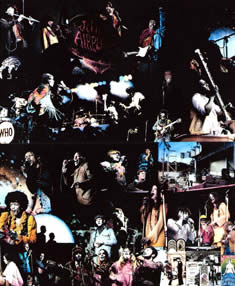 The fairgrounds’ enclosed performance arena, where the music took place, had an approved festival capacity of 7,000, but it was estimated that 8,500 jammed into it for Saturday night’s show.
The fairgrounds’ enclosed performance arena, where the music took place, had an approved festival capacity of 7,000, but it was estimated that 8,500 jammed into it for Saturday night’s show.
Festival-goers who wanted to see the musical performances were required to have either an ‘all-festival’ ticket or a separate ticket for each of the five scheduled concert events they wanted to attend in the arena: Friday night, Saturday afternoon and night, and Sunday afternoon and night. Ticket prices varied by seating area, and ranged from $3 to $6.50 ($21–46, adjusted for inflation).
The festival is remembered for the first major American appearances by The Jimi Hendrix Experience, The Who and Ravi Shankar, the first large-scale public performance of Janis Joplin and the introduction of Otis Redding.
The Monterey Pop Festival embodied the theme of California as a focal point for the counterculture and is generally regarded as one of the beginnings of the “Summer of Love” in 1967; the first rock festival had been held just one week earlier at Mount Tamalpais in Marin County, the KFRC Fantasy Fair and Magic Mountain Music Festival. Because Monterey was widely promoted and heavily attended, featured historic performances, and was the subject of a popular theatrical documentary film, it became an inspiration and a template for future music festivals, including the Woodstock Festival two years later.
The Mamas and the Papas
 The Mamas and the Papas was an American folk rock vocal group that recorded and performed from 1965 to 1968, reuniting briefly in 1971.
The Mamas and the Papas was an American folk rock vocal group that recorded and performed from 1965 to 1968, reuniting briefly in 1971.
They released five studio albums and seventeen singles, six of which made the top ten, and sold close to 40 million records worldwide.
The group was composed of John Phillips (1935–2001), Denny Doherty (1940–2007), Cass Elliot (1941–1974), and Michelle Phillips née Gilliam (b. 1944).
Their sound was based on vocal harmonies arranged by John Phillips, the songwriter, musician, and leader of the group who adapted folk to the new beat style of the early sixties.
Bob Dylan
Bob Dylan is an American singer-songwriter, artist and writer. He has been influential in popular music and culture for more than five decades. Much of his most celebrated work dates from the 1960s when his songs chronicled social unrest, although Dylan repudiated suggestions from journalists that he was a spokesman for his generation. Nevertheless, early songs such as “Blowin’ in the Wind” and “The Times They Are a-Changin'” became anthems for the American civil rights and anti-war movements. Leaving behind his initial base in the American folk music revival, his six-minute single “Like a Rolling Stone”, recorded in 1965, enlarged the range of popular music. Dylan’s mid-1960s recordings, backed by rock musicians, reached the top end of the United States music charts while also attracting denunciation and criticism from others in the folk movement.
 Dylan’s lyrics have incorporated various political, social, philosophical, and literary influences. They defied existing pop music conventions and appealed to the burgeoning counterculture. Initially inspired by the performances of Little Richard and the songwriting of Woody Guthrie, Robert Johnson, and Hank Williams, Dylan has amplified and personalized musical genres.
Dylan’s lyrics have incorporated various political, social, philosophical, and literary influences. They defied existing pop music conventions and appealed to the burgeoning counterculture. Initially inspired by the performances of Little Richard and the songwriting of Woody Guthrie, Robert Johnson, and Hank Williams, Dylan has amplified and personalized musical genres.
His recording career, spanning more than 50 years, has explored the traditions in American song—from folk, blues, and country to gospel, rock and roll, and rockabilly to English, Scottish, and Irish folk music, embracing even jazz and the Great American Songbook. Dylan performs with guitar, keyboards, and harmonica. Backed by a changing lineup of musicians, he has toured steadily since the late 1980s on what has been dubbed the Never Ending Tour. His accomplishments as a recording artist and performer have been central to his career, but songwriting is considered his greatest contribution.
Backed by a changing lineup of musicians, he has toured steadily since the late 1980s on what has been dubbed the Never Ending Tour. His accomplishments as a recording artist and performer have been central to his career, but songwriting is considered his greatest contribution.
Cream
Cream were a 1960s British rock supergroup power trio consisting of bassist/singer Jack Bruce, drummer Ginger Baker, and guitarist/singer Eric Clapton. The group’s third album, Wheels of Fire (1968), was the world’s first platinum-selling double album.
The band is widely regarded as the world’s first successful supergroup. In their career, they sold more than 15 million copies of their albums worldwide. Their music included songs based on traditional blues such as “Crossroads” and “Spoonful”, and modern blues such as “Born Under a Bad Sign”, as well as more eccentric songs such as “Strange Brew”, “Tales of Brave Ulysses” and “Toad”.
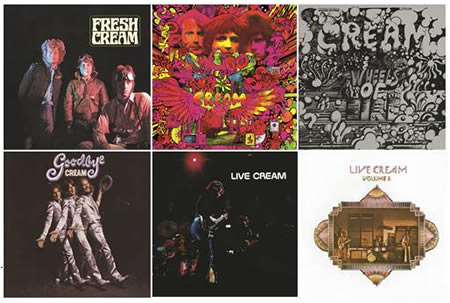
The band’s biggest hits are “I Feel Free” (UK, number 11), “Sunshine of Your Love” (US, number 5), “White Room” (US, number 6), “Crossroads” (US, number 28), and “Badge” (UK, number 18). The band made a significant impact on the popular music of the time, and, along with Jimi Hendrix and other notable guitarists and bands, popularized the use of the wah-wah pedal. They provided a heavy yet technically proficient musical theme that foreshadowed and influenced the emergence of British bands such as Led Zeppelin, The Jeff Beck Group, Deep Purple and Black Sabbath in the late 1960s and the early 1970s. The band’s live performances influenced progressive rock acts such as Rush. The band was inducted into the Rock and Roll Hall of Fame in 1993.
They were included in both Rolling Stone and VH1’s lists of the “100 Greatest Artists of All Time,” at number 67 and 61 respectively. They were also ranked number 16 on VH1’s “100 Greatest Artists of Hard Rock”
Jefferson Airplane
Jefferson Airplane was a San Francisco, California-based band who pioneered the American counterculture movement as well as psychedelic rock. Formed in 1965, the group defined the San Francisco Sound and was the first from the Bay Area to achieve international commercial success.
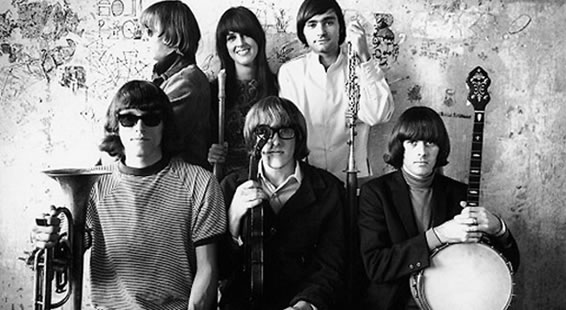
They were headliners at the three most famous American rock festivals of the 1960s—Monterey (1967), Woodstock (1969) and Altamont (1969)—in addition to the first Isle of Wight Festival (1968) in England. Their 1967 break-out record Surrealistic Pillow ranks on the short list of most significant recordings of the “Summer of Love”. Two songs from that album, “Somebody to Love” and “White Rabbit”, are among Rolling Stone’s “500 Greatest Songs of All Time.”
The “classic” line-up of Jefferson Airplane remained stable from 1967 to early 1970, and consisted of Marty Balin, Jack Casady, Spencer Dryden, Paul Kantner, Jorma Kaukonen and Grace Slick. The group broke up in 1972 and split into two bands: Hot Tuna and Jefferson Starship. Jefferson Airplane was inducted into the Rock and Roll Hall of Fame in 1996, and honored with the Grammy Lifetime Achievement Award in 2016
Peter Max
 Peter Max is an American artist known for using bright colors in his work. Max synthesized the “Summer of Love” into artworks from canvas to mugs and clocks and scarves and clothes and cruise-ships: a master of Pop Art he is the official portrait artist for the Statue of Liberty and welcome banners at the US Ports of Entry.
Peter Max is an American artist known for using bright colors in his work. Max synthesized the “Summer of Love” into artworks from canvas to mugs and clocks and scarves and clothes and cruise-ships: a master of Pop Art he is the official portrait artist for the Statue of Liberty and welcome banners at the US Ports of Entry.
His work is an indispensable guide for cultural literacy of the 1960s, and his work commands a solid following worldwide and is consistently collected by the art world
Bubblegum Pop
Bubblegum Pop a genre of pop music with an upbeat sound contrived and marketed to appeal to pre-teens and teenagers, that may be produced in an assembly-line process, driven by producers and often using unknown singers. Bubblegum’s classic period ran from 1967 to 1972. A second wave of bubblegum started two years later and ran until 1977 when disco took over and punk rock emerged.
The genre was predominantly a singles phenomenon rather than an album-oriented one. Also, because many acts were manufactured in the studio using session musicians, a large number of bubblegum songs were by one-hit wonders. Among the best-known acts of bubblegum’s golden era are 1910 Fruitgum Company, The Ohio Express and The Archies, an animated group which had the most successful bubblegum song with “Sugar, Sugar”, Billboard Magazine’s No. 1 single for 1969. Singer Tommy Roe, arguably, had the most bubblegum hits of any artist during this period, notably 1969’s “Dizzy”.
The Band
The Band was a Canadian-American roots rock group, originally consisting of Rick Danko (bass guitar, double bass, fiddle, vocals), Levon Helm (drums, mandolin, guitar, vocals), Garth Hudson (keyboards, saxophones, trumpet), Richard Manuel (piano, drums, vocals) and Robbie Robertson (guitar, percussion, vocals). The members of the Band first came together as they joined rockabilly singer Ronnie Hawkins’s backing group, the Hawks, one by one between 1958 and 1963.

In 1964, they separated from Hawkins, after which they toured and released a few singles as Levon and the Hawks and the Canadian Squires. The next year, Bob Dylan hired them for his U.S. tour in 1965 and world tour in 1966. Following the 1966 tour, the group moved with Dylan to Saugerties, New York, where they made the informal 1967 recordings that became The Basement Tapes, which forged the basis for their 1968 debut album, Music from Big Pink. Because they were always “the band” to various frontmen, Helm said the name “The Band” worked well when the group came into its own.The group began performing as the Band in 1968 and went on to release ten studio albums. Dylan continued to collaborate with the Band over the course of their career, including a joint 1974 tour.
The original configuration of the Band ended its touring career in 1976 with an elaborate live ballroom performance featuring numerous musical celebrities. This performance was immortalized in Martin Scorsese’s 1978 documentary The Last Waltz. The Band recommenced touring in 1983 without guitarist Robbie Robertson, who had found success with a solo career and as a Hollywood music producer. Following a 1986 show, Richard Manuel committed suicide, but the remaining three members continued to tour and record albums with a succession of musicians filling Manuel’s and Robertson’s roles; the final configuration of the group included Richard Bell (piano), Randy Ciarlante (drums), and Jim Weider (guitar). Danko died of heart failure in 1999, after which the group broke up for good. Levon Helm was diagnosed with throat cancer in 1998 and was unable to sing for several years, but he eventually regained the use of his voice. He continued to perform and released several successful albums until he succumbed to the disease in 2012.
The genre was predominantly a singles phenomenon rather than an album-oriented one. Also, because many acts were manufactured in the studio using session musicians, a large number of bubblegum songs were by one-hit wonders. Among the best-known acts of bubblegum’s golden era are 1910 Fruitgum Company, The Ohio Express and The Archies, an animated group which had the most successful bubblegum song with “Sugar, Sugar”, Billboard Magazine’s No. 1 single for 1969. Singer Tommy Roe, arguably, had the most bubblegum hits of any artist during this period, notably 1969’s “Dizzy”.
John Lennon
John Lennon was an English singer and songwriter who co-founded the Beatles (1960-70), the most commercially successful band in the history of popular music. With fellow member Paul McCartney, he formed a celebrated songwriting partnership.
 Born and raised in Liverpool, Lennon became involved in the skiffle craze as a teenager; his first band, the Quarrymen, evolved into the Beatles in 1960. When the group disbanded in 1970, Lennon embarked on a solo career that produced the albums John Lennon/Plastic Ono Band and Imagine, and songs such as “Give Peace a Chance”, “Working Class Hero”, and “Imagine”. After his marriage to Yoko Ono in 1969, he changed his name to John Ono Lennon. Lennon disengaged himself from the music business in 1975 to raise his infant son Sean, but re-emerged with Ono in 1980 with the new album Double Fantasy. He was murdered three weeks after its release.
Born and raised in Liverpool, Lennon became involved in the skiffle craze as a teenager; his first band, the Quarrymen, evolved into the Beatles in 1960. When the group disbanded in 1970, Lennon embarked on a solo career that produced the albums John Lennon/Plastic Ono Band and Imagine, and songs such as “Give Peace a Chance”, “Working Class Hero”, and “Imagine”. After his marriage to Yoko Ono in 1969, he changed his name to John Ono Lennon. Lennon disengaged himself from the music business in 1975 to raise his infant son Sean, but re-emerged with Ono in 1980 with the new album Double Fantasy. He was murdered three weeks after its release.
Lennon revealed a rebellious nature and acerbic wit in his music, writing, drawings, on film and in interviews. Controversial through his political and peace activism, he moved to Manhattan in 1971, where his criticism of the Vietnam War resulted in a lengthy attempt by Richard Nixon’s administration to deport him, while some of his songs were adopted as anthems by the anti-war movement and the larger counterculture.
John F. Kennedy
John F. Kennedy was an American politician who served as the 35th President of the United States from January 1961 until his assassination in November 1963. The Cuban Missile Crisis, the Bay of Pigs Invasion, the Nuclear Test Ban Treaty, the establishment of the Peace Corps, developments in the Space Race, the building of the Berlin Wall, the Trade Expansion Act to lower tariffs, and the Civil Rights Movement all took place during his presidency. A member of the Democratic Party, his New Frontier domestic program was largely enacted as a memorial to him after his death.

Kennedy’s time in office was marked by high tensions with Communist states. He increased the number of American military advisers in South Vietnam by a factor of 18 over Eisenhower. In Cuba, a failed attempt was made at the Bay of Pigs to overthrow the country’s dictator Fidel Castro in April 1961. He subsequently rejected plans by the Joint Chiefs of Staff to orchestrate false-flag attacks on American soil in order to gain public approval for a war against Cuba. In October 1962, it was discovered Soviet ballistic missiles had been deployed in Cuba; the resulting period of unease, termed the Cuban Missile Crisis, is seen by many historians as the closest the human race has ever come to nuclear war between nuclear-armed belligerents.
After military service in the United States Naval Reserve in World War II, Kennedy represented Massachusetts’s 11th congressional district in the U.S. House of Representatives from 1947 to 1953. He was elected subsequently to the U.S. Senate and served as the junior Senator from Massachusetts from 1953 until 1960. Kennedy defeated Vice President, and Republican candidate, Richard Nixon in the 1960 U.S. Presidential Election. At age 43, he became the youngest elected president and the second-youngest president (after Theodore Roosevelt, who was 42 when he became president after the assassination of William McKinley). Kennedy was also the first person born in the 20th century to serve as president. To date, Kennedy has been the only Roman Catholic president and the only president to have won a Pulitzer Prize (for his biography Profiles in Courage).
Kennedy was assassinated in Dallas, Texas, on November 22, 1963. Lee Harvey Oswald was arrested that afternoon and determined to have fired shots that hit the President from a sixth-floor window of the Texas School Book Depository. Dallas nightclub owner Jack Ruby mortally wounded Oswald two days later in a jail corridor. The FBI and the Warren Commission officially concluded that Oswald was the lone assassin, but its report was sharply criticized. The United States House Select Committee on Assassinations (HSCA) agreed that Oswald fired the shots that killed the president, but also concluded that Kennedy was likely assassinated as the result of a conspiracy. The majority of Americans alive at the time of the assassination: 52% to 29%, and continuing through 2013 (61% to 30%), believed that there was a conspiracy and that Oswald was not the only shooter.
Since the 1960s, information concerning Kennedy’s private life has come to light, including his health problems and allegations of infidelity. Kennedy continues to rank highly in historians’ polls of U.S. presidents and with the general public. His average approval rating of 70% is the highest of any president in Gallup’s history of systematically measuring job approval.
Lyndon B. Johnson
Lyndon B. Johnson was an American politician who served as the 36th President of the United States from 1963 to 1969, assuming the office after serving as the 37th Vice President of the United States under President John F. Kennedy, from 1961 to 1963. Johnson was a Democrat from Texas, who served as a United States Representative from 1937 to 1949 and as a United States Senator from 1949 to 1961. He spent six years as Senate Majority Leader, two as Senate Minority Leader, and two as Senate Majority Whip.
 Johnson ran for the Democratic nomination in the 1960 presidential election. Although unsuccessful, he was chosen by Senator John F. Kennedy of Massachusetts to be his running mate. They went on to win a close election over Richard Nixon and Henry Cabot Lodge. Johnson was sworn in as Vice President on January 20, 1961. Two years and ten months later, on November 22, 1963, Johnson succeeded Kennedy as President following the latter’s assassination. He ran for a full term in the 1964 election, winning by a landslide over Republican opponent Arizona Senator Barry Goldwater. He is one of only four people who have served as President, Vice President, Senator, and Representative. Johnson was renowned for his domineering, sometimes abrasive, personality and the “Johnson treatment”—his aggressive coercion of powerful politicians to advance legislation.
Johnson ran for the Democratic nomination in the 1960 presidential election. Although unsuccessful, he was chosen by Senator John F. Kennedy of Massachusetts to be his running mate. They went on to win a close election over Richard Nixon and Henry Cabot Lodge. Johnson was sworn in as Vice President on January 20, 1961. Two years and ten months later, on November 22, 1963, Johnson succeeded Kennedy as President following the latter’s assassination. He ran for a full term in the 1964 election, winning by a landslide over Republican opponent Arizona Senator Barry Goldwater. He is one of only four people who have served as President, Vice President, Senator, and Representative. Johnson was renowned for his domineering, sometimes abrasive, personality and the “Johnson treatment”—his aggressive coercion of powerful politicians to advance legislation.
Johnson designed the “Great Society” legislation upholding civil rights, public broadcasting, Medicare, Medicaid, aid to education, the arts, urban and rural development, public services, and his “War on Poverty”. Assisted in part by a growing economy, the War on Poverty helped millions of Americans rise above the poverty line during Johnson’s presidency. Civil rights bills signed by Johnson banned racial discrimination in public facilities, interstate commerce, the workplace, and housing; and the Voting Rights Act banned certain requirements in southern states used to disenfranchise African Americans. With the passage of the Immigration and Nationality Act of 1965, the country’s immigration system was reformed and all racial origin quotas were removed (replaced by national origin quotas).
Johnson escalated American involvement in the Vietnam War. In 1964, Congress passed the Gulf of Tonkin Resolution, which granted Johnson the power to use military force in Southeast Asia without having to ask for an official declaration of war. The number of American military personnel in Vietnam increased dramatically, from 16,000 advisors in non-combat roles in 1963, to 550,000 in early 1968, many in combat roles. American casualties soared and the peace process bogged down. Growing unease with the war stimulated a large, angry antiwar movement based especially on university campuses in the U.S. and abroad.
Johnson faced further troubles when summer riots broke out in most major cities after 1965, and crime rates soared, as his opponents raised demands for “law and order” policies. While he began his presidency with widespread approval, support for Johnson declined as the public became upset with both the war and the growing violence at home. In 1968, the Democratic Party factionalized as antiwar elements denounced Johnson; he ended his bid for renomination after a disappointing finish in the New Hampshire primary. Republican Richard Nixon was elected to succeed him, as the New Deal coalition that had dominated presidential politics for 36 years collapsed. After he left office in January 1969, Johnson returned to his Texas ranch where he died of a heart attack at age 64 on January 22, 1973.
Martin Luther King Jr.
Martin Luther King Jr. was an American Baptist minister and activist who was a leader in the African-American Civil Rights Movement. He is best known for his role in the advancement of civil rights using nonviolent civil disobedience based on his Christian beliefs.
 King became a civil rights activist early in his career. He led the 1955 Montgomery bus boycott and helped found the Southern Christian Leadership Conference (SCLC) in 1957, serving as its first president. With the SCLC, King led an unsuccessful 1962 struggle against segregation in Albany, Georgia (the Albany Movement), and helped organize the 1963 nonviolent protests in Birmingham, Alabama.
King became a civil rights activist early in his career. He led the 1955 Montgomery bus boycott and helped found the Southern Christian Leadership Conference (SCLC) in 1957, serving as its first president. With the SCLC, King led an unsuccessful 1962 struggle against segregation in Albany, Georgia (the Albany Movement), and helped organize the 1963 nonviolent protests in Birmingham, Alabama.
King also helped to organize the 1963 March on Washington, where he delivered his famous “I Have a Dream” speech. There, he established his reputation as one of the greatest orators in American history.
On October 14, 1964, King received the Nobel Peace Prize for combating racial inequality through nonviolent resistance.
In 1965, he helped to organize the Selma to Montgomery marches, and the following year he and SCLC took the movement north to Chicago to work on segregated housing. In the final years of his life, King expanded his focus to include opposition towards poverty and the Vietnam War, alienating many of his liberal allies with a 1967 speech titled “Beyond Vietnam”.
In 1968, King was planning a national occupation of Washington, D.C., to be called the Poor People’s Campaign, when he was assassinated on April 4 in Memphis, Tennessee. His death was followed by riots in many U.S. cities.
Robert F. Kennedy
Robert F. Kennedy was an American politician from Massachusetts. He served as a senator for New York from 1965 until his assassination in 1968. He was previously the 64th U.S. Attorney General from 1961 to 1964, serving under his older brother, President John F. Kennedy and his successor, President Lyndon B. Johnson. An icon of modern American liberalism, and a member of the Democratic Party, Kennedy ran for its presidential nomination in the 1968 election.
 After serving in the United States Naval Reserve as a Seaman Apprentice from 1944 to 1946, Kennedy graduated from Harvard University and the University of Virginia. Prior to entering public office, he worked as a correspondent for the Boston Post and as an assistant counsel to the Senate committee chaired by Joe McCarthy. He gained national attention as the chief counsel of the Senate Labor Rackets Committee from 1957 to 1959, where he publicly challenged Teamsters President Jimmy Hoffa over the corrupt practices of its union and authored The Enemy Within, a book about corruption in organized labor.
After serving in the United States Naval Reserve as a Seaman Apprentice from 1944 to 1946, Kennedy graduated from Harvard University and the University of Virginia. Prior to entering public office, he worked as a correspondent for the Boston Post and as an assistant counsel to the Senate committee chaired by Joe McCarthy. He gained national attention as the chief counsel of the Senate Labor Rackets Committee from 1957 to 1959, where he publicly challenged Teamsters President Jimmy Hoffa over the corrupt practices of its union and authored The Enemy Within, a book about corruption in organized labor.
Kennedy was the campaign manager for his brother John in the 1960 presidential election. He was appointed Attorney General after the successful election and served as the closest adviser to the president from 1961 to 1963. His tenure is best known for its advocacy for the Civil Rights Movement, the crusade against organized crime and the Mafia, and involvement in U.S. foreign policy related to Cuba. After his brother’s assassination, he remained in office in the Johnson administration for a few months. He left to run for the United States Senate in New York in 1964 defeating Republican incumbent Kenneth Keating.
In 1968, Kennedy was a leading candidate for the Democratic nomination for the presidency, appealing especially to poor, African-American, Hispanic, and Catholic voters. Shortly after midnight on June 5, 1968, after defeating Senator Eugene McCarthy in the California presidential primary, he was shot by Sirhan Sirhan, a 24-year-old Palestinian, and died the following day.
Woman’s Rights
Feminism
 The role of women as full-time homemakers in industrial society was challenged in 1963, when US feminist Betty Friedan published The Feminine Mystique, giving momentum to the women’s movement and influencing what many called Second-wave feminism. Other activists, such as Gloria Steinem and Angela Davis, either organized, influenced, or educated many of a younger generation of women to endorse and expand feminist thought. Feminism gained further currency within the protest movements of the late 1960s, as women in movements such as Students for a Democratic Society rebelled against the “support” role they had been consigned to within the male-dominated New Left, as well as against manifestations and statements of sexism within some radical groups. The 1970 pamphlet Women and Their Bodies, soon expanded into the 1971 book Our Bodies, Ourselves, was particularly influential in bringing about the new feminist consciousness.
The role of women as full-time homemakers in industrial society was challenged in 1963, when US feminist Betty Friedan published The Feminine Mystique, giving momentum to the women’s movement and influencing what many called Second-wave feminism. Other activists, such as Gloria Steinem and Angela Davis, either organized, influenced, or educated many of a younger generation of women to endorse and expand feminist thought. Feminism gained further currency within the protest movements of the late 1960s, as women in movements such as Students for a Democratic Society rebelled against the “support” role they had been consigned to within the male-dominated New Left, as well as against manifestations and statements of sexism within some radical groups. The 1970 pamphlet Women and Their Bodies, soon expanded into the 1971 book Our Bodies, Ourselves, was particularly influential in bringing about the new feminist consciousness.
The Doors
The Doors were an American rock band formed in 1965 in Los Angeles, with vocalist Jim Morrison, keyboardist Ray Manzarek, guitarist Robby Krieger, and drummer John Densmore. The band got its name from the title of Aldous Huxley’s book The Doors of Perception, which itself was a reference to a quote made by William Blake, “If the doors of perception were cleansed, everything would appear to man as it is, infinite.” They were unique and among the most controversial and influential rock acts of the 1960s, mostly because of Morrison’s lyrics and charismatic but unpredictable stage persona. After Morrison’s death in 1971 at age 27, the remaining members continued as a trio until disbanding in 1973.
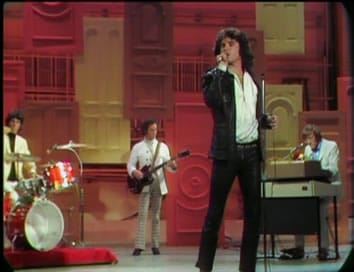 Signing with Elektra Records in 1966, the Doors released eight albums between 1967 and 1971. All but one hit the Top 10 on the Billboard 200 and went platinum or better. Their self-titled debut album (1967) was their first in a series of Top 10 albums in the United States, followed by Strange Days (also 1967), Waiting for the Sun (1968), The Soft Parade (1969), Morrison Hotel (1970), Absolutely Live (1970) and L.A. Woman (1971), with 20 Gold, 14 Platinum, and 5 Multi-Platinum album awards in the United States alone. By the end of 1971, it was reported that the Doors had sold 4,190,457 albums domestically and 7,750,642 singles.
Signing with Elektra Records in 1966, the Doors released eight albums between 1967 and 1971. All but one hit the Top 10 on the Billboard 200 and went platinum or better. Their self-titled debut album (1967) was their first in a series of Top 10 albums in the United States, followed by Strange Days (also 1967), Waiting for the Sun (1968), The Soft Parade (1969), Morrison Hotel (1970), Absolutely Live (1970) and L.A. Woman (1971), with 20 Gold, 14 Platinum, and 5 Multi-Platinum album awards in the United States alone. By the end of 1971, it was reported that the Doors had sold 4,190,457 albums domestically and 7,750,642 singles.
The band had three million-selling singles in the U.S. with “Light My Fire”, “Hello, I Love You” and “Touch Me”. After Morrison’s death in 1971, the surviving trio released two albums Other Voices and Full Circle with Manzarek and Krieger sharing lead vocals. The three members also collaborated on the spoken word recording of Morrison’s An American Prayer in 1978 and on the “Orange County Suite” for a 1997 boxed set. Manzarek, Krieger and Densmore reunited in 2000 for an episode of VH1’s “Storytellers” and subsequently recorded Stoned Immaculate: The Music of The Doors with a variety of vocalists.
Although the Doors’ active career ended in 1973, their popularity has persisted. According to the RIAA, they have sold 33 million certified units in the US and over 100 million records worldwide, making them one of the best-selling bands of all time. The Doors have been listed as one of the greatest artists of all time by many magazines, including Rolling Stone, which ranked them 41st on its list of the “100 Greatest Artists of All Time”. The Doors were the first American band to accumulate eight consecutive gold and platinum LP’s.
Woodstock
Woodstock was a music festival attracting an audience of over 400,000 people, scheduled over three days on a dairy farm in New York state from August 15 to 17, 1969, but which ran over four days to August 18, 1969.
Billed as “An Aquarian Exposition: 3 Days of Peace & Music”, it was held at Max Yasgur’s 600-acre (240 ha; 0.94 sq mi) dairy farm in the Catskills near the hamlet of White Lake in the town of Bethel.
Bethel, in Sullivan County, is 43 miles (69 km) southwest of the town of Woodstock, New York, in adjoining Ulster County.
During the sometimes rainy weekend, 32 acts performed outdoors before an audience of 400,000 people. It is widely regarded as a pivotal moment in popular music history, as well as the definitive nexus for the larger counterculture generation.

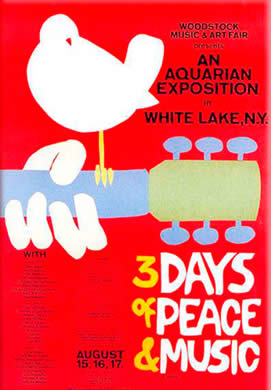
Kent State Shooting
Kent State Shooting occurred at Kent State University in Kent, Ohio, in the United States and involved the shooting of unarmed college students by the Ohio National Guard on Monday, May 4, 1970. There were 28 guards who admitted to firing on top of the hill, 25 of these guards fired 55 rounds into the air and into the ground, two of the guards fired .45cal pistol shots, three into the crowd, and three into the air, one guard fired birdshot into the air (James Russell was also hit with a shotgun’s birdshot, some believe that some of the shot may have ricocheted off a tree and hit him). The guardsmen fired 67 rounds over a period of 13 seconds, killing four students and wounding nine others, one of whom suffered permanent paralysis.
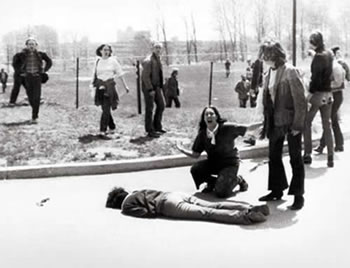 Some of the students who were shot had been protesting the Cambodian Campaign, which President Richard Nixon announced during a television address on April 30. Other students who were shot had been walking nearby or observing the protest from a distance.
Some of the students who were shot had been protesting the Cambodian Campaign, which President Richard Nixon announced during a television address on April 30. Other students who were shot had been walking nearby or observing the protest from a distance.
There was a significant national response to the shootings: Hundreds of universities, colleges, and high schools closed throughout the United States due to a student strike of 4 million students, and the event further affected public opinion, at an already socially contentious time, over the role of the United States in the Vietnam War.
Rolling Stones
Rolling Stones are an English rock band formed in London in 1962. The first settled line-up consisted of Brian Jones (guitar, harmonica), Ian Stewart (piano), Mick Jagger (lead vocals, harmonica), Keith Richards (guitar), Bill Wyman (bass) and Charlie Watts (drums). Stewart was removed from the official line-up in 1963 but continued as an occasional pianist until his death in 1985. Jones departed the band less than a month prior to his death in 1969, having already been replaced by Mick Taylor, who remained until 1975.
 Subsequently, Ronnie Wood has been on guitar in tandem with Richards. Following Wyman’s departure in 1993, Darryl Jones has been the main bassist. Other notable keyboardists for the band have included Nicky Hopkins, active from 1967 to 1982; Billy Preston through the mid-1970s (most prominent on Black and Blue) and Chuck Leavell, active since 1982.
Subsequently, Ronnie Wood has been on guitar in tandem with Richards. Following Wyman’s departure in 1993, Darryl Jones has been the main bassist. Other notable keyboardists for the band have included Nicky Hopkins, active from 1967 to 1982; Billy Preston through the mid-1970s (most prominent on Black and Blue) and Chuck Leavell, active since 1982.
The band was first led by Jones but after teaming as the band’s songwriters, Jagger and Richards assumed de facto leadership.
The Rolling Stones were in the vanguard of the British Invasion of bands that became popular in the US in 1964–65. At first noted for their longish hair as much as their music, the band identified with the youthful and rebellious counterculture of the 1960s. Critic Sean Egan states that within a year of the release of their 1964 debut album, they “were being perceived by the youth of Britain and then the world as representatives of opposition to an old, cruel order—the antidote to a class-bound, authoritarian culture.” They were instrumental in making blues a major part of rock and roll and changing the international focus of blues culture to the less sophisticated blues typified by Chess Records artists such as Muddy Waters—writer of “Rollin’ Stone”, after which the band is named. After a short period of musical experimentation that culminated with the poorly received and largely psychedelic album Their Satanic Majesties Request (1967), the group returned to its bluesy roots with Beggars Banquet (1968) which—along with its follow-ups, Let It Bleed (1969), Sticky Fingers (1971) and Exile on Main St (1972)—is generally considered to be the band’s best work and are considered the Rolling Stones’ “Golden Age”. It was during this period the band were first introduced on stage as “The World’s Greatest Rock and Roll Band”. Musicologist Robert Palmer attributed the “remarkable endurance” of the Rolling Stones to being “rooted in traditional verities, in rhythm-and-blues and soul music”, while “more ephemeral pop fashions have come and gone”.
Timothy Leary
Timothy Leary was an American psychologist and writer known for advocating the exploration of the therapeutic potential of psychedelic drugs under controlled conditions. Leary conducted experiments under the Harvard Psilocybin Project during American legality of LSD and psilocybin, resulting in the Concord Prison Experiment and the Marsh Chapel Experiment. Leary’s colleague, Richard Alpert (Ram Dass), was fired from Harvard University on May 27, 1963 for giving psilocybin to an undergraduate student. Leary was planning to leave Harvard when his teaching contract expired in June, the following month. He was fired, for “failure to keep classroom appointments”, with his pay docked on April 30.
 Leary believed that LSD showed potential for therapeutic use in psychiatry. He used LSD himself and developed a philosophy of mind expansion and personal truth through LSD. He popularized catchphrases that promoted his philosophy, such as “turn on, tune in, drop out”, “set and setting”, and “think for yourself and question authority”. He also wrote and spoke frequently about transhumanist concepts involving space migration, intelligence increase, and life extension (SMI²LE), and developed the eight-circuit model of consciousness in his book Exo-Psychology (1977). He gave lectures, occasionally billing himself as a “performing philosopher”.
Leary believed that LSD showed potential for therapeutic use in psychiatry. He used LSD himself and developed a philosophy of mind expansion and personal truth through LSD. He popularized catchphrases that promoted his philosophy, such as “turn on, tune in, drop out”, “set and setting”, and “think for yourself and question authority”. He also wrote and spoke frequently about transhumanist concepts involving space migration, intelligence increase, and life extension (SMI²LE), and developed the eight-circuit model of consciousness in his book Exo-Psychology (1977). He gave lectures, occasionally billing himself as a “performing philosopher”.
Ken Kesey and the Merry Pranksters
Ken Kesey and his Merry Pranksters helped shape the developing character of the 1960s counterculture when they embarked on a cross-country voyage during the summer of 1964 in a psychedelic school bus named “Furthur”. Beginning in 1959, Kesey had volunteered as a research subject for medical trials financed by the CIA’s MK ULTRA project.
These trials tested the effects of LSD, psilocybin, mescaline, and other psychedelic drugs. After the medical trials, Kesey continued experimenting on his own, and involved many close friends; collectively they became known as “The Merry Pranksters”. The Pranksters visited Harvard LSD proponent Timothy Leary at his Millbrook, New York retreat, and experimentation with LSD and other psychedelic drugs, primarily as a means for internal reflection and personal growth, became a constant during the Prankster trip.
The Pranksters created a direct link between the 1950s Beat Generation and the 1960s psychedelic scene; the bus was driven by Beat icon Neal Cassady, Beat poet Allen Ginsberg was on board for a time, and they dropped in on Cassady’s friend, Beat author Jack Kerouac – though Kerouac declined to participate in the Prankster scene. After the Pranksters returned to California, they popularized the use of LSD at so-called “Acid Tests”, which initially were held at Kesey’s home in La Honda, California, and then at many other West Coast venues.
Music
“The 60s were a leap in human consciousness. Mahatma Gandhi, Malcolm X, Martin Luther King, Che Guevara, Mother Teresa, they led a revolution of conscience. The Beatles, The Doors, Jimi Hendrix created revolution and evolution themes. The music was like Dalí, with many colors and revolutionary ways. The youth of today must go there to find themselves.” – Carlos Santana
During the early 1960s, Britain’s new wave of musicians gained popularity and fame in the United States. Artists such as the Beatles paved the way for their compatriots to enter the US market.
The Beatles themselves were influenced by many artists, among them American singer/songwriter Bob Dylan, who was a lyrical inspiration as well as their introduction to marijuana. Dylan’s early career as a protest singer had been inspired by artists like Pete Seeger and his hero Woody Guthrie. Other folksingers, like Joan Baez and Peter, Paul and Mary, took the songs of the era to new audiences and public recognition.
The music of the 1960s moved towards an electric, psychedelic version of rock, thanks largely to Bob Dylan’s decision to play an electric guitar at the 1965 Newport Folk Festival.
The newly popularized electric sound of rock was then built upon and molded into psychedelic rock by artists like The 13th Floor Elevators and British bands Pink Floyd and the Beatles. The Beach Boys‘ 1966 album Pet Sounds also paved the way for later hippie acts, with Brian Wilson’s writing interpreted as a “plea for love and understanding.”
Pet Sounds served as a major source of inspiration for other contemporary acts, most notably directly inspiring the Beatles’ Sgt. Pepper’s Lonely Hearts Club Band. The single “Good Vibrations” soared to number one globally, completely changing the perception of what a record could be. It was during this period that the highly anticipated album Smile was to be released. However, the project collapsed and The Beach Boys released a downgraded version called Smiley Smile, which failed to make a big commercial impact but was also highly influential, most notably on The Who’s Pete Townshend.
The Beatles went on to become the most prominent commercial exponents of the “psychedelic revolution” (e.g., Revolver, Sgt. Pepper’s Lonely Hearts Club Band and Magical Mystery Tour) in the late 1960s.
In the United States, bands that exemplified the counterculture were becoming huge commercial and mainstream successes. These included The Mamas & the Papas (If You Can Believe Your Eyes and Ears), Big Brother and the Holding Company (Cheap Thrills), Jimi Hendrix (Are You Experienced), Jefferson Airplane (Surrealistic Pillow), The Doors (The Doors) and Sly and the Family Stone (Stand!). Bands and other musicians, such as the Grateful Dead, Neil Young (Canada), David Peel, Phil Ochs, The Fugs, Quicksilver Messenger Service, John Sebastian, Melanie, The Velvet Underground, Frank Zappa, Captain Beefheart, Santana, CSNY, Country Joe and the Fish, and The Holy Modal Rounders were considered key to the counterculture movement.
While the hippie scene was born in California, an edgier scene emerged in New York City that put more emphasis on avant-garde and art music. Bands such as The Velvet Underground came out of this underground music scene, which was predominantly centered at Andy Warhol’s legendary Factory. The Velvet Underground supplied the music for the Exploding Plastic Inevitable, a series of multimedia events staged by Warhol and his collaborators in 1966 and 1967. The Velvet Underground’s lyrics were considered risqué for the era, since they discussed sexual fetishism, transgender identities, and the use of drugs associated with Warhol’s Factory and its superstars.
 The Jimi Hendrix Experience performs for the Dutch television show Fenklup in March 1967 Detroit’s MC5 also came out of the underground rock music scene of the late 1960s. They introduced a more aggressive evolution of garage rock which was often fused with sociopolitical and countercultural lyrics of the era, such as in the song “Motor City Is Burning” (a John Lee Hooker cover adapting the story of the Detroit Race Riot of 1943 to the Detroit riot of 1967). MC5 had ties to radical leftist organizations such as “Up Against the Wall Motherfuckers” and John Sinclair’s White Panther Party, and MC5 performed a lengthy set before the 1968 Democratic National Convention in Chicago, where an infamous riot subsequently broke out between police and students protesting the Vietnam War and the recent assassinations of Martin Luther King, Jr. and Robert Kennedy. MC5, The Stooges and the aforementioned Velvet Underground, are now seen as an influence on the protopunk sound that would lead to punk rock and heavy metal music in the late 1970s.
The Jimi Hendrix Experience performs for the Dutch television show Fenklup in March 1967 Detroit’s MC5 also came out of the underground rock music scene of the late 1960s. They introduced a more aggressive evolution of garage rock which was often fused with sociopolitical and countercultural lyrics of the era, such as in the song “Motor City Is Burning” (a John Lee Hooker cover adapting the story of the Detroit Race Riot of 1943 to the Detroit riot of 1967). MC5 had ties to radical leftist organizations such as “Up Against the Wall Motherfuckers” and John Sinclair’s White Panther Party, and MC5 performed a lengthy set before the 1968 Democratic National Convention in Chicago, where an infamous riot subsequently broke out between police and students protesting the Vietnam War and the recent assassinations of Martin Luther King, Jr. and Robert Kennedy. MC5, The Stooges and the aforementioned Velvet Underground, are now seen as an influence on the protopunk sound that would lead to punk rock and heavy metal music in the late 1970s.
Another hotbed of the 1960s counterculture was Austin, Texas, with two of the era’s legendary music venues-the Vulcan Gas Company and the Armadillo World Headquarters-and musical talent like Janis Joplin, the 13th Floor Elevators, Shiva’s Headband, the Conqueroo, and, later, Stevie Ray Vaughan. Austin was also home to a large New Left activist movement, one of the earliest underground papers, The Rag, and cutting edge graphic artists like Fabulous Furry Freak Brothers creator Gilbert Shelton, underground comix pioneer Jack Jackson (Jaxon), and surrealist armadillo artist Jim Franklin.
The 1960s was also an era of rock festivals, which played an important role in spreading the counterculture across the US. The Monterey Pop Festival, which launched Jimi Hendrix’s career in the US, was one of the first of these festivals. Britain’s 1968–1970 Isle of Wight Festivals drew big names such as The Who, The Doors, Joni Mitchell, Hendrix, Dylan, and others. The 1969 Woodstock Festival in New York state became a symbol of the movement, although the 1970 Isle of Wight Festival drew a larger crowd. Some believe the era came to an abrupt end with the infamous Altamont Free Concert held by The Rolling Stones, in which heavy-handed security from the Hells Angels resulted in the stabbing of an audience member, apparently in self-defense, as the show descended into chaos.
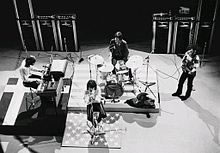 As the psychedelic revolution progressed, lyrics grew more complex, (such as Jefferson Airplane’s “White Rabbit”). Long-playing albums enabled artists to make more in-depth statements than could be made in just a single song (such as the Mothers of Invention’s satirical Freak Out!). Even the rules governing single songs were stretched, and singles lasting longer than three minutes emerged, such as Dylan’s “Like a Rolling Stone”, Arlo Guthrie’s “Alice’s Restaurant”, and Iron Butterfly’s 17-minute-long “In-A-Gadda-Da-Vida.”
As the psychedelic revolution progressed, lyrics grew more complex, (such as Jefferson Airplane’s “White Rabbit”). Long-playing albums enabled artists to make more in-depth statements than could be made in just a single song (such as the Mothers of Invention’s satirical Freak Out!). Even the rules governing single songs were stretched, and singles lasting longer than three minutes emerged, such as Dylan’s “Like a Rolling Stone”, Arlo Guthrie’s “Alice’s Restaurant”, and Iron Butterfly’s 17-minute-long “In-A-Gadda-Da-Vida.”
The 1960s saw the protest song gain a sense of political self-importance, with Phil Ochs’s “I Ain’t Marching Anymore” and Country Joe and the Fish’s “I-Feel-Like-I’m-Fixin’-to-Die-Rag” among the many anti-war anthems that were important to the era.
Free jazz is an approach to jazz music that was first developed in the 1950s and 1960s. Though the music produced by free jazz composers varied widely, the common feature was a dissatisfaction with the limitations of bebop, hard bop, and modal jazz, which had developed in the 1940s and 1950s. Each in their own way, free jazz musicians attempted to alter, extend, or break down the conventions of jazz, often by discarding hitherto invariable features of jazz, such as fixed chord changes or tempos. While usually considered experimental and avant-garde, free jazz has also oppositely been conceived as an attempt to return jazz to its “primitive”, often religious roots, and emphasis on collective improvisation. Free jazz is strongly associated with the 1950s innovations of Ornette Coleman and Cecil Taylor and the later works of saxophonist John Coltrane. Other important pioneers included Charles Mingus, Eric Dolphy, Albert Ayler, Archie Shepp, Joe Maneri and Sun Ra. Although today “free jazz” is the generally used term, many other terms were used to describe the loosely defined movement, including “avant-garde”, “energy music” and “The New Thing”.
During its early and mid-60s heyday, much free jazz was released by established labels such as Prestige, Blue Note and Impulse, as well as independents such as ESP Disk and BYG Actuel. Free improvisation or free music is improvised music without any rules beyond the logic or inclination of the musician(s) involved. The term can refer to both a technique (employed by any musician in any genre) and as a recognizable genre in its own right. Free improvisation, as a genre of music, developed in the U.S. and Europe in the mid to late 1960s, largely as an outgrowth of free jazz and modern classical musics. None of its primary exponents can be said to be famous within mainstream; however, in experimental circles, a number of free musicians are well known, including saxophonists Evan Parker, Anthony Braxton, Peter Brötzmann and John Zorn, drummer Christian Lillinger, trombonist George Lewis, guitarists Derek Bailey, Henry Kaiser and Fred Frith and the improvising groups The Art Ensemble of Chicago and AMM.
Allmusic Guide states that “until around 1967, the worlds of jazz and rock were nearly completely separate”. The term, “jazz-rock” (or “jazz/rock”) is often used as a synonym for the term “jazz fusion”. However, some make a distinction between the two terms. The Free Spirits have sometimes been cited as the earliest jazz-rock band. During the late 1960s, at the same time that jazz musicians were experimenting with rock rhythms and electric instruments, rock groups such as Cream and the Grateful Dead were “beginning to incorporate elements of jazz into their music” by “experimenting with extended free-form improvisation”. Other “groups such as Blood, Sweat & Tears directly borrowed harmonic, melodic, rhythmic and instrumentational elements from the jazz tradition”.
The rock groups that drew on jazz ideas (like Soft Machine, Colosseum, Caravan, Nucleus, Chicago, Spirit and Frank Zappa) turned the blend of the two styles with electric instruments. Since rock often emphasized directness and simplicity over virtuosity, jazz-rock generally grew out of the most artistically ambitious rock subgenres of the late 1960s and early 70s: psychedelia, progressive rock, and the singer/songwriter movement.”
Miles Davis’ Bitches Brew sessions, recorded in August 1969 and released the following year, mostly abandoned jazz’s usual swing beat in favor of a rock-style backbeat anchored by electric bass grooves. The recording “…mixed free jazz blowing by a large ensemble with electronic keyboards and guitar, plus a dense mix of percussion.” Davis also drew on the rock influence by playing his trumpet through electronic effects and pedals. While the album gave Davis a gold record, the use of electric instruments and rock beats created a great deal of consternation amongst some more conservative jazz critics.
Anti-nuclear
 The application of nuclear technology, both as a source of energy and as an instrument of war, has been controversial. Scientists and diplomats have debated the nuclear weapons policy since before the atomic bombing of Hiroshima in 1945.
The application of nuclear technology, both as a source of energy and as an instrument of war, has been controversial. Scientists and diplomats have debated the nuclear weapons policy since before the atomic bombing of Hiroshima in 1945.
The public became concerned about nuclear weapons testing from about 1954, following extensive nuclear testing in the Pacific. In 1961, at the height of the Cold War, about 50,000 women brought together by Women Strike for Peace marched in 60 cities in the United States to demonstrate against nuclear weapons. In 1963, many countries ratified the Partial Test Ban Treaty which prohibited atmospheric nuclear testing.
Some local opposition to nuclear power emerged in the early 1960s, and in the late 1960s some members of the scientific community began to express their concerns. In the early 1970s, there were large protests about a proposed nuclear power plant in Wyhl, Germany. The project was cancelled in 1975 and anti-nuclear success at Wyhl inspired opposition to nuclear power in other parts of Europe and North America. Nuclear power became an issue of major public protest in the 1970s.
Law Enforcement
The confrontations between college students (and other activists) and law enforcement officials became one of the hallmarks of the era. Many younger people began to show deep distrust of police, and terms such as “fuzz” and “pig” as derogatory epithets for police reappeared, and became key words within the counterculture lexicon. The distrust of police was based not only on fear of police brutality during political protests, but also on generalized police corruption – especially police manufacture of false evidence, and outright entrapment, in drug cases. In the US, the social tension between elements of the counterculture and law enforcement reached the breaking point in many notable cases, including: the Columbia University protests of 1968 in New York City, the 1968 Democratic National Convention protests in Chicago, the arrest and imprisonment of John Sinclair in Ann Arbor, Michigan, and the Kent State shootings at Kent State University in Kent, Ohio, where National Guardsman acted as surrogates for police. Police malfeasance was also an ongoing issue in the UK during the era.
Marijuana, LSD, and other recreational drugs
During the 1960s, this second group of casual lysergic acid diethylamide (LSD) users evolved and expanded into a subculture that extolled the mystical and religious symbolism often engendered by the drug’s powerful effects, and advocated its use as a method of raising consciousness. The personalities associated with the subculture, gurus such as Timothy Leary and psychedelic rock musicians such as the Grateful Dead, Pink Floyd, Jimi Hendrix, The Byrds, The 13th Floor Elevators, Ultimate Spinach, Janis Joplin, Crosby, Stills & Nash, The Doors, Blue Cheer, The Chambers Brothers, Country Joe and the Fish, Big Brother and the Holding Company, Jefferson Airplane and The Beatles, soon attracted a great deal of publicity, generating further interest in LSD.
Crosby, Stills, and Nash
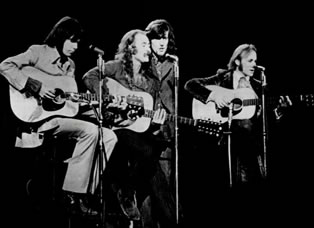 Crosby, Stills, and Nash were an American-British folk rock supergroup made up of David Crosby, Stephen Stills, and Graham Nash. They were known as Crosby, Stills, Nash & Young (CSNY) when joined by occasional fourth member Neil Young. They were noted for their intricate vocal harmonies, often tumultuous interpersonal relationships, political activism, and lasting influence on US music and culture. Crosby, Stills & Nash were inducted into the Rock and Roll Hall of Fame and all three members were also inducted for their work in other groups (Crosby for the Byrds, Stills for Buffalo Springfield and Nash for the Hollies). Neil Young has also been inducted, but as a solo artist and as a member of Buffalo Springfield, not for his work with the group
Crosby, Stills, and Nash were an American-British folk rock supergroup made up of David Crosby, Stephen Stills, and Graham Nash. They were known as Crosby, Stills, Nash & Young (CSNY) when joined by occasional fourth member Neil Young. They were noted for their intricate vocal harmonies, often tumultuous interpersonal relationships, political activism, and lasting influence on US music and culture. Crosby, Stills & Nash were inducted into the Rock and Roll Hall of Fame and all three members were also inducted for their work in other groups (Crosby for the Byrds, Stills for Buffalo Springfield and Nash for the Hollies). Neil Young has also been inducted, but as a solo artist and as a member of Buffalo Springfield, not for his work with the group
The Byrds were an American rock band, formed in Los Angeles, California in 1964. The band underwent multiple line-up changes throughout its existence, with frontman Roger McGuinn (known as Jim McGuinn until mid-1967) remaining the sole consistent member, until the group disbanded in 1973. Although they only managed to attain the huge commercial success of contemporaries like the Beatles, the Beach Boys, and the Rolling Stones for a short period (1965–66), the Byrds are today considered by critics to be one of the most influential bands of the 1960s. Initially, they pioneered the musical genre of folk rock, melding the influence of the Beatles and other British Invasion bands with contemporary and traditional folk music. As the 1960s progressed, the band was also influential in originating psychedelic rock, raga rock, and country rock.

The band’s signature blend of clear harmony singing and McGuinn’s jangly twelve-string Rickenbacker guitar has continued to be influential on popular music up to the present day. Among the band’s most enduring songs are their cover versions of Bob Dylan’s “Mr. Tambourine Man” and Pete Seeger’s “Turn! Turn! Turn! (to Everything There Is a Season)”, along with the self-penned originals, “I’ll Feel a Whole Lot Better”, “Eight Miles High”, “So You Want to Be a Rock ‘n’ Roll Star”, “Ballad of Easy Rider” and “Chestnut Mare”.
The original five-piece line-up of the Byrds consisted of Jim McGuinn (lead guitar, vocals), Gene Clark (tambourine, vocals), David Crosby (rhythm guitar, vocals), Chris Hillman (bass guitar, vocals), and Michael Clarke (drums). However, this version of the band was relatively short-lived and by early 1966, Clark had left due to problems associated with anxiety and his increasing isolation within the group. The Byrds continued as a quartet until late 1967, when Crosby and Clarke also departed the band. McGuinn and Hillman decided to recruit new members, including country-rock pioneer Gram Parsons, but by late 1968, Hillman and Parsons had also exited the band. McGuinn, who by this time had changed his name to Roger after a flirtation with the Subud religion, elected to rebuild the band’s membership and between 1968 and 1973, he helmed a new incarnation of the Byrds, featuring guitarist Clarence White among others. McGuinn disbanded the then current line-up in early 1973, to make way for a reunion of the original quintet. The Byrds’ final album was released in March 1973, with the reunited group disbanding soon afterward.
